The WordPress full site editor (FSE) opens up a world of design possibilities, letting you customize your site’s header, footer, templates, and more, all in one place. But what happens when this powerful tool greets you with nothing but a blank screen?
Don’t panic, you are not the only one this is happening to. We can help you work through a few simple troubleshooting steps to solve this frustrating issue.
This article will guide you through our most effective solutions to fix the WordPress blank site editor problem, so you can get back to designing your website in no time.
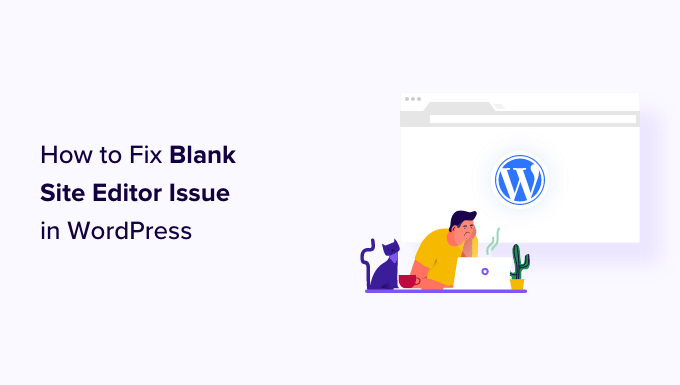
What Is the Blank Site Editor Issue in WordPress?
The full site editor in WordPress is an editing interface that works with block themes and gives you more control over your website design. It allows you to use blocks for styling your website’s header, footer, sidebar, and other sections.
You can access it by selecting Appearance » Editor from the WordPress admin sidebar whenever you wish to customize your WordPress theme.
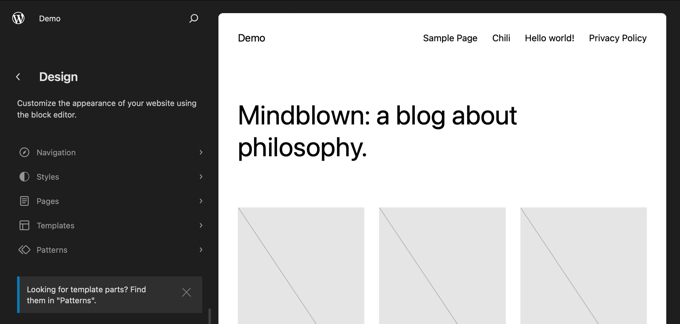
However, some users report seeing a blank page whenever they try to access the WordPress site editor.
Some users just see a completely blank screen. That screen may be dark or light in color.

This issue is caused by incorrect WordPress settings. We will show you how to fix it in Method 1.
Other users can see part of the site editor’s interface, but the preview of their website is blank. They might also see a spinning circle indicating that the editor is trying to load the preview, but it never appears.
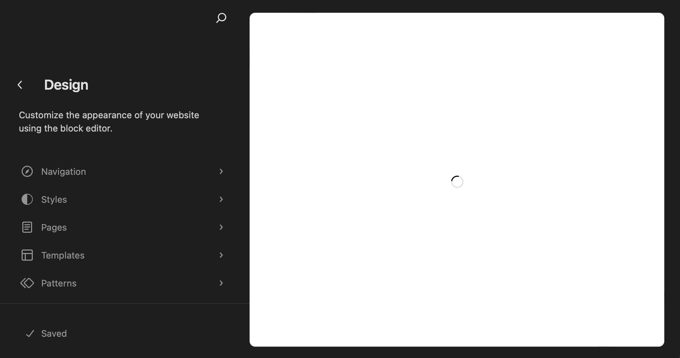
This happens when someone has disabled the REST API in WordPress. We show you how to fix this issue in Method 2.
With that being said, let’s take a look at how to fix the blank site editor in WordPress. You can use the links below to jump to the method you need to use:
Fixing the Blank Site Editor Issue in WordPress Settings
If you are seeing a completely blank screen when you try to use the site editor, then you have a problem with the URL settings on your WordPress website.
First, you need to navigate to Settings » General in your WordPress dashboard. Now, you need to find the ‘WordPress Address (URL)’ and ‘Site Address (URL)’ settings.
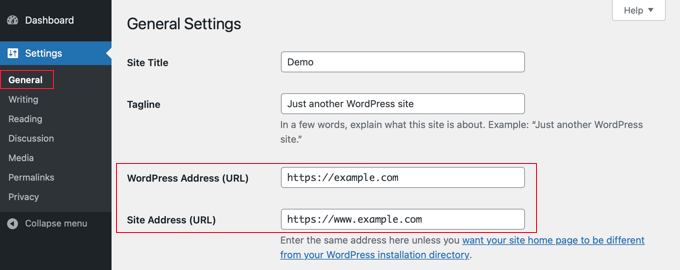
You need to make sure that the site address matches the WordPress address.
In particular, you need to make sure that if the WordPress address has a www or non-www URL, then the site address matches that exactly. In our screenshot above, these do not match, so ‘www.’ needs to be removed from the site address URL.
Once the two settings are identical, you need to scroll to the bottom of the General Settings page and click the ‘Save Changes’ button to store your settings.
You can now open up the site editor again, and it should work.
Fixing the Blank Site Editor Issue by Enabling the REST API
If the site editor is not loading a preview of your website, then the REST API might be disabled on your WordPress website.
What Is the REST API in WordPress?
The REST API was introduced in WordPress 4.4. It is useful for plugin developers because it provides an interface where they can access WordPress functionality and data to build their plugins.
The REST API is enabled by default, and the site editor uses it to render a preview of your website. So, if you have disabled the REST API on your website, then the site editor won’t be able to show a preview of your site.
Some website owners choose to disable the REST API in the hope of improving their site’s security and performance. They may have followed our guide on how to disable the JSON REST API in WordPress.
Our guide shows you how to disable the REST API using two methods: adding a code snippet in WPCode or installing the Disable REST API plugin.
To enable the REST API again, you will need to disable that code snippet or plugin, depending on which method you originally chose.
Disabling the REST API Code Snippet in WPCode
If you used WPCode to disable the REST API, then you need to navigate to Code Snippets in WordPress admin.
Once there, you need to find the ‘Disable WordPress REST API’ snippet and switch the ‘Status’ toggle off.
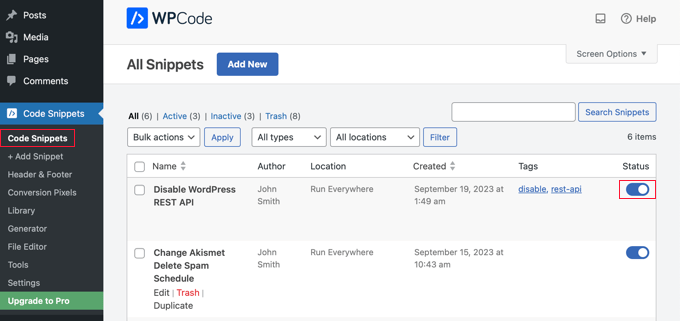
Alternatively, if you disabled the REST API by adding code directly to your functions.php file instead of using WPCode, then you will need to open that file using an FTP client or the file manager app in your web hosting dashboard.
Then, you must edit the file and remove the custom code.
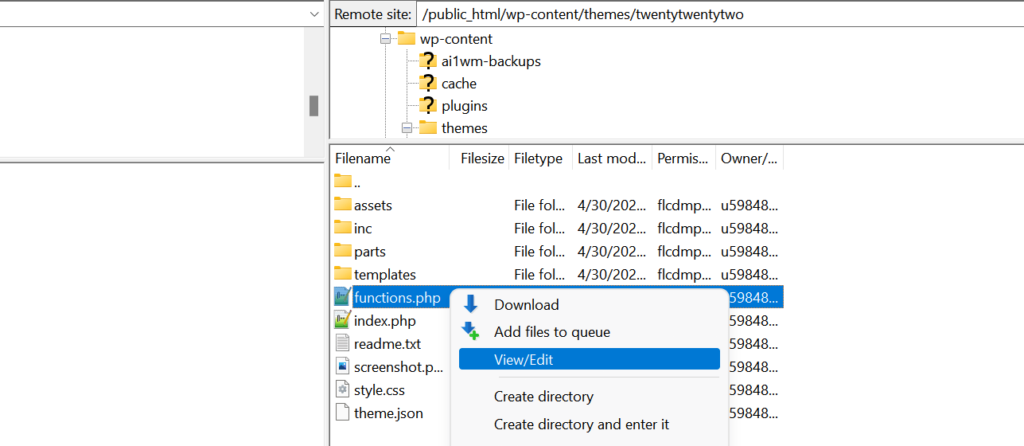
You should now be able to access the site editor and see the preview of your website.
Disabling the Disable REST API Plugin
If you used a WordPress plugin to disable the REST API, then you need to navigate to Plugins » Installed Plugins.
Once there, you need to scroll down to the plugin and click the ‘Deactivate’ link. In our example, we are working with the Disable REST API plugin, but you will use the same method if you have a different plugin installed.
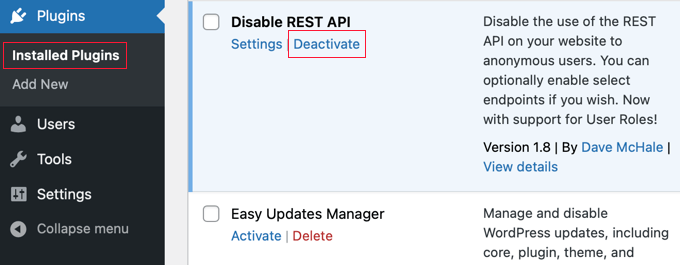
You can now open up the site editor, and it should be working properly again.
Alternative: Using a Page Builder Plugin to Design Your Website
While the full site editor is a helpful tool for designing your website, it has some limitations. It is only available with block themes, and you will lose your customizations if you change your theme.
By contrast, WordPress page builders like SeedProd provide a drag-and-drop interface where you can design all your individual pages using blocks. They are compatible with any WordPress theme, and you can change your theme without losing your customizations.
You can get started by choosing a template/site kit or building completely from scratch.
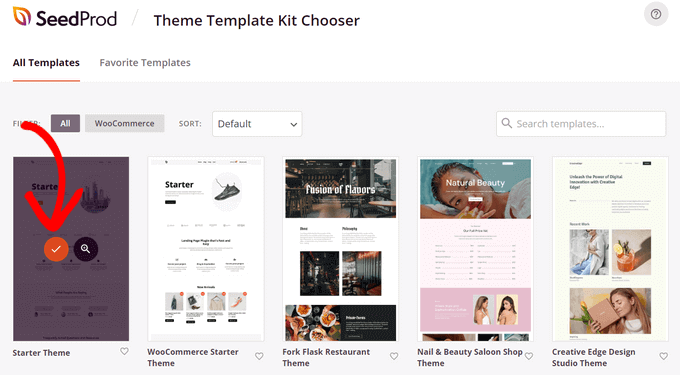
You can even use SeedProd to design an entire theme for your website. For more details, you can see our guide on how to create a custom WordPress theme without writing any code.
We hope this tutorial helped you learn how to fix the blank site editor issue in WordPress. You may also want to see our guide to the most common WordPress errors and how to fix them or our expert pick of the best drag-and-drop page builder plugins to design your website more easily.
If you liked this article, then please subscribe to our YouTube Channel for WordPress video tutorials. You can also find us on Twitter and Facebook.





Helenmary Cody
I ran into this issue while designing a custom theme on my local machine. Everything was working perfectly and then all of a sudden I couldn’t use the theme editor. After much beating of my head into my desk, I realized that the little change I had just made to a comment in style.css was causing the problem! The comment “Template: archive-dog” made WordPress think the theme was a child theme of the archive-dog theme which didn’t exist. Changing it to “Template – archive-dog” fixed the issue.
Lesson learned: don’t use colons in the style.css file.
WPBeginner Support
Thanks for sharing this for anyone who is customizing their own theme in case they run into this error
Admin
Dennis Muthomi
I’ve dealt with this problem tons of times while managing WordPress sites for clients, especially after security plugins were installed.
The REST API solution was especially helpful – I recently had a client who turned it off during security setup. One additional tip I’d suggest is always backup your site before touching the Settings » General URL stuff. Trust me, it’s saved me when a client’s site went down after a wrong URL change!
The troubleshooting steps you’ve laid out are super helpful. I’ll definitely be sharing this to my colleagues!
Paddy
Also – before you try any other step, if you have a caching plugin running on the site, clear that. I use Litespeed and have seen the blank white page a few times when trying to edit posts (particularly when duplicating them, and then editing) and clearing the LS cache solves the problem.
WPBeginner Support
Thank you for sharing this for another option to try
Admin
gail
Turning off my plugins one by one worked for me. But my Settings > General page on a Mac in Chrome doesn’t look anything like what is shown in the article. The top is the same, but I can’t find the WordPress URL vs. Site URL part. Is the screen shot in the article up to date?
WPBeginner Support
The article is up to date, just to be sure you would want to make certain you are an admin user on your site or if you are using WordPress.com then we would recommend taking a look at our article below!
https://www.wpbeginner.com/beginners-guide/self-hosted-wordpress-org-vs-free-wordpress-com-infograph/
Admin
Vic
Commenting because I arrived here thru search, and finally solved my blank-page editor issue in a different way: I opened the list of plugins in one tab and the page editor in a different tab, then went thru my plug-ins and deactivated/reactivated them one at a time, doing a hard-refresh (Ctrl+F5) on the page editor tab after each deactivation to find the guilty plug-in. In my case, it was the “Advanced Bootstrap Blocks”. Happy to be back in action!
WPBeginner Support
Glad to hear you were able to solve the issue on your site
Admin
Gail
Thank you, Vic, your method worked for me! In my case, it was Gutenberg.
Jiří Vaněk
I have encountered several times what a different address in the settings can cause. This article can solve many headaches. But I read about rest api in this context for the first time. It’s good to know.
Ralph
Thank you for this article. It’s quite short but gives all the information needed!
WPBeginner Support
You’re welcome, we try to keep focused on these articles for troubleshooting errors
Admin
Damian Cichosz
The article provides clear explanations of the issue, including potential causes and solutions. The step-by-step instructions and screenshots make it easy to follow, even for less tech-savvy users.
The suggestion to use page builder plugins like SeedProd as an alternative is a great addition. Page builders offer more flexibility and compatibility, which can be valuable for users looking for an efficient way to design their websites without the hassle of a blank site editor
WPBeginner Support
Glad to hear you found our article helpful
Admin